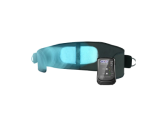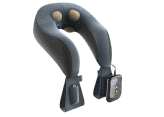As some of the most utilized parts of the body, the back, neck, shoulders and limbs are all vulnerable to aches and pains from daily living. And while there are many pain relief methods out there including medications and procedures, you may find yourself looking for ways to manage pain on your own terms. TENS & EMS is a popular, alternative option that can offer pain-relieving effects without being invasive.
Read on to learn more about these pain therapies and how they work together to deliver temporary upper back pain relief, and temporary relief elsewhere in the upper body as well.
What Are Some of the Most Common Causes of Upper Body Pain?
Upper Back Pain
The upper back area can be vulnerable to overuse, strain and injuries. While the bones may not be as mobile as the bones in the lower back, they do work hard with help of the ribs to keep your back stable and to protect vital organs. This can make your upper back prone to aches and pains. Fractures, osteoarthritis and pressure on the spinal nerves can also cause stiffness and pain in the upper back.
Neck and Shoulder Pain
Neck and shoulder pain is often caused by sprains and strains from activities, overexertion, or incorrect posture. Other common causes of neck and shoulder pain include:
- Soft tissue injury: A soft tissue injury in the neck can lead to stiffness, spasms and reduced mobility.
- Prolonged awkward posture: Holding your neck in an awkward position for a prolonged period of time can lead to strains in the muscles and tendons of the neck and shoulders. This usually happens at night while asleep or while being active.
- Rotator cuff tear: The rotator cuff is a group of four tendons that hold your upper arm to your shoulder blade. These tendons can be injured during lifting, or after repetitive use. This can cause pain when the shoulder is moved and can even cause longer-term mobility problems.
- Whiplash injury: Whiplash is the tearing of muscles, tendons, and ligaments in your neck from a sudden movement. Whiplash often causes muscle spasms in the neck and shoulders, pain and numbness in the arms and hands.

Hand and Wrist Pain
It’s easy to take our hands and wrists for granted. As some of the most active parts of the body, the hands and wrists are prone to many types of aches and pains. Below are some of the factors that can often contribute to hand and wrist pain:
- Carpal tunnel syndrome is caused by pressure on a nerve (the median nerve) in the wrist. Symptoms include tingling, numbness, weakness, or pain of the fingers and hand.
- Tendon pain is actually a symptom of tendinosis, a series of very small tears (microtears) in the tissue in and around the tendon. In addition to pain and tenderness, common symptoms of tendon injury include decreased strength and movement in the affected area.
- Writer's cramps can develop with repeated hand or finger motion, such as when writing or typing.
- Osteoarthritis is the progressive breakdown of the tissue that protects and cushions joints (cartilage) and is most common in the hands. It may cause stiffness, swelling and pain with movement.
- Rheumatoid arthritis is an autoimmune and inflammatory disease where the immune system attacks many joints at once. RA in the hands and wrists may cause stiffness, pain with movement and possibly deformity.

How Do TENS and EMS Pain Therapies Work to Temporarily Relieve Pain?
TENS & EMS work together in pain therapy devices to help pain sufferers find temporary upper back pain relief, and relief in other parts of the upper body, too. Keep reading to learn more about these pain therapies and how they can be applied to your upper body pain from daily living.
What is TENS Therapy?
TENS (Transcutaneous Electrical Nerve Stimulation) pain therapy works by “stopping” pain signals from reaching the brain; more specifically, TENS devices use safe and gentle electrical pulses that travel along the nerves to disrupt how pain signals are registered in the brain. As a result, TENS is an effective option for those looking to temporarily alleviate sensations of pain that come from everyday activities, work, chores and more. TENS can also be used to provide symptomatic relief of chronic pain and arthritis pain.
What about EMS Therapy?
While TENS targets the nerves, EMS (Electrical Muscle Stimulation) targets the muscles with contracting stimulation. EMS contractions are beneficial because, as the muscles move, local blood circulation increases; this means that nutrient-rich, oxygenated blood can be delivered to the sore muscles. Stimulating healthy muscles using EMS can also improve and facilitate muscle performance.
DR-HO’S Proprietary AMP Technology Helps Keep the Stimulations Unpredictable
DR-HO’S TENS & EMS devices provide over 300 different stimulations using proprietary AMP (auto-modulating pulse) technology that constantly varies in wavelength, frequency and rest periods. These stimulations are programmed to automatically change, so you get a soothing variety of pulses that keep the stimulation unpredictable and effective!

Learn more about DR-HO’S TENS & EMS Devices!
5 Other Ways to Care for Your Pain at Home
Home remedies can also help you find relief when the pain strikes. Always consult your preferred healthcare provider for a diagnosis, and to let them know when you are making a change to your routine. Try some of the following home remedies to find upper back pain relief and relief in other parts of the upper body:
1. Take a break from physical activities that can aggravate your upper body pain: Give yourself adequate rest before returning to physical activities. Don’t let too much time pass, however, as inactivity can also lead to upper back pain! Start your activities again slowly with care.
2. Stretch it out: Stretch your upper back often and incorporate exercises into your workout routine that target the upper back, neck, shoulders and arm muscles. This can reduce your risks of injuries, prevent further pain and improve flexibility.
3. Prioritize deep and restorative sleep: Adequate sleep is crucial in managing pain and promoting healing. Practice habits that help you get a restful night’s sleep; for example, make your bedroom quiet and dark, limit screen time at least an hour before bedtime and establish a regular bedtime schedule.
4. Practice good posture: Don’t slump or slouch, while sitting and while standing as well. Aim for a straight posture with your shoulders relaxed and your tailbone tucked in slightly.
5. Add fiber into your diet: Research shows that people who eat a high-fiber diet that includes plenty of nutrient-rich fruits, vegetables, beans, nuts and whole grains are less likely to experience arthritis. And don’t forget to drink plenty of water with your fiber! Water helps fiber work more effectively in your body.

Add a new form of relief to your daily routine!
Feel more confident about your upper body pain management routine with the help of TENS, EMS and easy home remedies. Start feeling better, sooner by taking action today!
Learn more about TENS on the DR-HO’S Blog!
TENS Machines: This is Everything You Need to Know
How to Choose a TENS Machine
Do TENS Units Really Work?
How Do TENS Machines Work?
TENS Machine Side Effects: Is TENS Therapy Safe?
How Long is it Safe to Use TENS For
Can TENS Machines Help With Muscle Recovery Post Workout?














